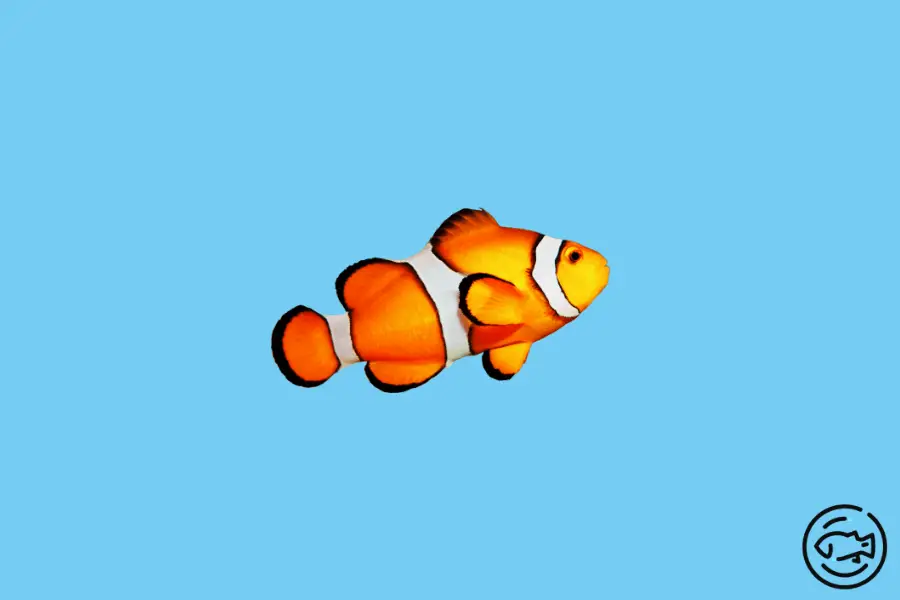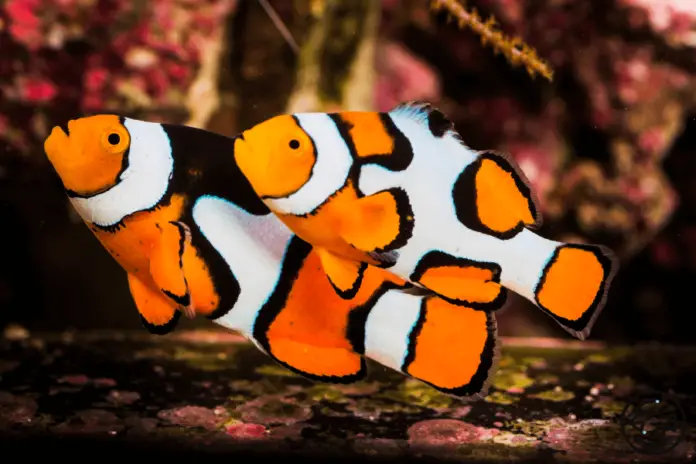The Picasso clownfish (Amphiprion percula), also known as the Picasso anemonefish, is a marine species in the family Pomacentridae. The Picasso clownfish is native to the Indo-Pacific region and can be found from Papua New Guinea to Vanuatu and the Great Barrier Reef. It is a popular species in the aquarium trade.
Origin
The Picasso clownfish is a member of the family Pomacentridae, which includes damselfishes, chromises, and anemonefishes. It is one of 28 species in the genus Amphiprion and was first described by German naturalist and explorer Wilhelm Peters in 1852.
This clownfish is a small fish with a maximum length of 6-8 cm. It has a white body with black spots and orange fins.
This fish is very similar in appearance to the closely related red sea anemonefish (Amphiprion ocellaris), and the two species can only be distinguished by their patterns of black spots.
Species Profile
The Picasso clownfish (Amphiprion percula) is a species of anemonefish that is native to the reefs of the Indo-Pacific.
It is one of the most popular fish in the aquarium trade due to its vibrant coloration and peaceful demeanor.
This clownfish gets its name from its unique patterning, which resembles the Cubist paintings of Pablo Picasso.
It is found in tropical reefs from Australia to Japan. It prefers to live near anemones, as they protect from predators.
Due to its popularity, the Picasso clownfish is often collected from the wild. This can stress wild populations, so it is important to purchase captive-bred clownfish when possible.
Appearance

The Picasso clownfish is a small fish with a maximum length of 6 cm (2.4 in). It has a white body with black spots and orange fins.
This clownfish is very similar in appearance to the closely related red sea anemone fish (Amphiprion ocellaris), and the two species can only be distinguished by their patterns of black spots.
Life Cycle
The Picasso clownfish has a typical anemonefish life cycle. They are born as a male and will live as a male unless it enters into a harem with a larger female. If the largest fish in a harem dies, the second-largest fish will change sex and take its place.
Sexing The Picasso
Picasso fish can change sex depending on the social structure of their group. If the female Picasso clownfish dies, the largest male in the group will change sex and take her place.
They are sequential hermaphrodites, meaning they can change sex multiple times during their lifetime. These fish are born male and generally turn into female clownfish when they reach adulthood.
Their diet consists mostly of zooplankton and algae, and they live in groups of 2-5 fish with a single dominant female Picasso clownfish.
They have a life span of 5-7 years and are named after the Spanish artist Pablo Picasso because of their unique coloration.
Size & Lifespan
The Picasso clownfish is a small fish with a maximum length of 6 cm (2.4 in). It has a typical anemonefish lifespan of 4-7 years in the wild and up to 10 years in captivity.
Care
They are hardy fish and can live in many aquarium conditions, but they prefer an aquarium with plenty of hiding places and a sandy substrate. They are peaceful fish but can be aggressive towards other clownfish species.
Diet
The Picasso clownfish is an omnivorous species and will eat various foods, including algae, small crustaceans, and zooplankton. In the aquarium, they can be fed a diet of frozen or live foods and flakes or pellets designed for marine fish.
Tank Mates
The Picasso clownfish is a peaceful species that gets along well with other tank mates. It is important to avoid aggressive species, as Picasso clownfish can be bullied.
They are also known to be good jumpers, so it is important to have a tight-fitting lid on the aquarium.
Water Conditions
The Picasso clownfish is a relatively tolerant species and can adapt to various water conditions.
However, it is important to maintain good water quality, as these clownfish are sensitive to ammonia and nitrite.
They prefer a temperature range of 24-28°Celsius (75-82°Fahrenheit), a pH of 8.1-8.4, and salinity of 1.020-1.025.
Breeding
Breeding Picasso clownfish in the home aquarium is relatively easy and can be done by providing a suitable anemone or spawning site.
The female clownfish will lay 200-1000 eggs, fertilized by the male. The eggs will hatch in 7-10 days, and the fry will be free-swimming 3-4 weeks later.
Conservation
The Picasso clownfish is not considered a threatened species and is not currently under any conservation measures.
However, like all marine fish, it is susceptible to overfishing and habitat destruction. It is important to purchase clownfish that have been sustainably raised in captivity to help protect wild populations.
Do They Make Good Pets?
The Picasso clownfish is a popular home aquarium species due to its bright colors and relatively easy care.
They are a peaceful species that gets along well with other tank mates and can be bred in the home aquarium.
While they are not considered a threatened species, it is important only to purchase clownfish raised in captivity to help protect the wild ones.
Parasites
The Picasso clownfish is susceptible to a variety of parasites, including Cryptocaryon irritans (marine ich), Amyloodinium ocellatum (velvet disease), and Ancylostomidae (anchor worms).
These parasites can cause various problems, including skin irritation, loss of appetite, and death.
It is important to quarantine new fish before adding them to the tank and regularly inspect them for signs of parasites.
If parasites are found, it is important to seek treatment from a qualified aquarium veterinarian.
Common Health Problems
The Picasso clownfish is susceptible to various common health problems, including ammonia and nitrite poisoning, velvet disease, and marine ich.
It is important to maintain good water quality and to quarantine new fish before adding them to the tank. If fish show signs of illness, it is important to seek treatment from a qualified aquarium veterinarian.
Vulnerability Of Predation
The Picasso clownfish is a relatively small species and is vulnerable to predation by various larger fish.
Avoiding aggressive tank mates and providing plenty of hiding places in the aquarium are important.
If they are kept with anemones, they will receive some protection from predators.
Are They Peaceful or Aggressive?
The Picasso clownfish is a relatively peaceful species and gets along well with other tank mates. They are not considered a threat to humans and can even be kept with smaller fish species.
However, these clownfish can be aggressive toward each other and should only be kept together if there is plenty of space in the aquarium. If they are kept with anemones, they will receive some protection from predators.
Quick Tips
– The Picasso clownfish is a prevalent home aquarium species due to its radiant colors and relatively easy care.
– They are a peaceful species that gets along well with other tank mates and can be bred in the home aquarium.
– While they are not considered an endangered species, it is necessary only to buy the ones that have been sustainably grown in captivity.
– The Picasso clownfish is sensitive to various parasites, including marine ich, velvet disease, and anchor worms. These parasites can cause various problems, including skin irritation, loss of appetite, and death.
– It is important to quarantine new fish before adding them to the tank and regularly inspect fish for signs of parasites. If parasites are found, it is important to seek treatment from a qualified aquarium veterinarian.
– The Picasso clownfish is also susceptible to common health problems such as ammonia and nitrite poisoning.
– It is important to maintain good water quality and to quarantine new fish before adding them to the tank. If fish show signs of illness, it is essential to opt for treatment from a veterinarian.
– Picasso clownfish are straightforward to manage and make a fantastic addition to any home aquarium.
Conclusion
In conclusion, the Picasso clownfish is a popular and relatively easy-to-care-for species that makes a great addition to any home aquarium.
They are a peaceful species that gets along well with other tank mates and can be bred in the home aquarium.
However, they are susceptible to various parasites, and it is important to quarantine new fish before adding them to the tank.
If fish show signs of illness, it is important to seek treatment from a qualified aquarium veterinarian.
This clownfish is also vulnerable to predation by a variety of larger fish, so it is important to provide plenty of hiding places in the aquarium.



